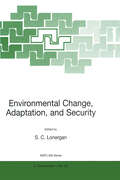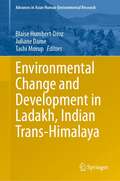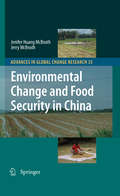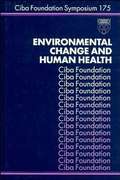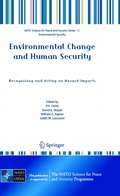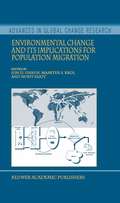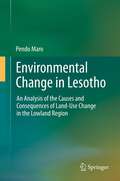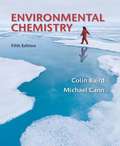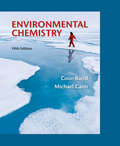- Table View
- List View
Environmental Change, Adaptation, and Security (NATO Science Partnership Subseries: 2 #65)
by S. LonerganThe chapters in this volume are edited versions of papers presented at the NATO Ad vanced Research Workshop on Environmental Change Adaptation and Security held in Budapest, Hungary, from October 16 - 18, 1997. As is evident in this volume, the papers ranged from descriptions of environmental and health issues in Russia and Eastern Europe to models of sustainable land use. This diversity of perspectives on environ ment and security is indicative of both the breadth of this new area of research as well as the varied background of the researchers involved. The discussions at the NATO workshop were remarkably animated and exciting, not surprising given the interest in the topic. I think this vitality is reflected in the papers in this volume as well. The main purpose of the NATO ARW is to foster research links among researchers from NATO countries and Central and Eastern European States, Russia, and the Newly Independent States. In editing this volume, a decision was made to keep to the spirit of this purpose and-if at all possible-include all papers prepared for the workshop. This required extensive editing and rewriting of some of the papers (and consequent delays in production). A determination was made early in the process by the workshop steering committee that the value of publishing the entire collection of articles out weighed the advantages of accepting only a limited number.
Environmental Change and Agricultural Sustainability in the Mekong Delta (Advances in Global Change Research #45)
by Mart A. Stewart and Peter A. CoclanisThe Mekong Delta of Vietnam is one of the most productive agricultural areas in the world. The Mekong River fans out over an area of about 40,000 sq kilometers and over the course of many millennia has produced a region of fertile alluvial soils and constant flows of energy. Today about a fourth of the Delta is under rice cultivation, making this area one of the premier rice granaries in the world. The Delta has always proven a difficult environment to manipulate, however, and because of population pressures, increasing acidification of soils, and changes in the Mekong’s flow, environmental problems have intensified. The changing way in which the region has been linked to larger flows of commodities and capital over time has also had an impact on the region: For example, its re-emergence in recent decades as a major rice-exporting area has linked it inextricably to global markets and their vicissitudes. And most recently, the potential for sea level increases because of global warming has added a new threat. Because most of the region is on average only a few meters above sea level and because any increase of sea level will change the complex relationship between tides and down-river water flow, the Mekong Delta is one of the areas in the world most vulnerable to the effects of climate change. How governmental policy and resident populations have in the past and will in coming decades adapt to climate change as well as several other emerging or ongoing environmental and economic problems is the focus of this collection.
Environmental Change and Development in Ladakh, Indian Trans-Himalaya (Advances in Asian Human-Environmental Research)
by Blaise Humbert-Droz Juliane Dame Tashi MorupThe Trans-Himalayan region of Ladakh has witnessed important changes linked to its geo-strategic importance, the rapid development of means of communication with other parts of India, socio-economic transformation processes and the effects of climate change. The sixteen chapters document these key changes, ranging from melting glaciers and extreme weather events to the exponential increase in infrastructure, tourist and military activities. The book examines the impact these changes are having on the environment and on the socio-economics and identity of Ladakhi communities. The book also attempts to evaluate the likely direction of future changes, identify some of the main environmental challenges faced by Ladakh in the 21st century, and provide perspectives for sustainable development of the high mountain region.
Environmental Change and Food Security in China (Advances in Global Change Research #35)
by Jenifer Huang McBeath Jerry McBeathAbstract This chapter defines food security as the condition reached when a nation’s population has access to sufficient, safe, and nutritious food to meet its dietary needs and food preferences. It stresses China’s importance to global food security because of its population size. The chapter introduces the contents of the volume and then treats briefly food security in ancient and dynastic (211 bc–1912) China. It examines environmental stressors, such as population growth, natural disasters, and insect pests as well as imperial responses (for example, irrigation, flood control, storage and transportation systems). The chapter also briefly int- duces the Republican era (1912–1949) and compares environmental stressors and government responses then to those of the imperial period. Keywords Food system • Food security • Food production regions • Environmental stressors (Population growth • Natural disasters • Insect pests and Plant diseases • Deforestation • Climate change) • Irrigation systems • Flood control • Grand Canal 1. 1 The Problem of Food Security and Environmental Change Food is the material basis to human survival, and in each nation-state, providing a system for the development, production, and distribution of food and its security is a primary national objective. Many forces have influenced the food security of peoples since ancient times, with particular challenges from natural disasters (floods, famines, drought, and pestilence) and growing populations globally.
Environmental Change and Human Health (Novartis Foundation Symposia #175)
by Kate Ackrill Gregory R. Bock John V. LakeDiscusses those aspects of environmental change which might have direct or indirect effects on human health. Includes discussions on water pollution, agricultural pollution, genetic disease and exotic tropical diseases as well as human nutrition and population growth.
Environmental Change and Human Security in Africa and the Middle East
by Mohamed Behnassi Katriona McGladeThis volume brings together insights on the interactions between environmental change and human security in the Middle East and Africa. These regions face particular challenges in relation to environmental degradation, the decline of natural resources and consequent risks to current and future human security.The chapters provide topical analysis from a range of disciplines on the theory, discourse, policy and practice of responding to global environmental change and threats to human security.Case studies from Morocco, Tunisia, Egypt, Turkey, Iraq and Syria provide empirical evidence, with a focus section dedicated to the critical issue of water resources and water security in the region.The contributions demonstrate above all that the risks posed to human security arise through multiple and interconnected processes operating across diverse spatial and temporal scales. The complexity of these processes requires new ways of thinking and intervening. As a contribution, the current volume provides engaging insights from theory and practice for those seeking to address the challenges of environmental change.
Environmental Change and Human Security: Recognizing and Acting on Hazard Impacts (NATO Science for Peace and Security Series C: Environmental Security)
by W. G. Kepner Judith Lancaster Peter H. Liotta David A. MouatEnvironmental and Human Security: Then and Now 1 2 ALAN D. HECHT AND P. H. LIOTTA * 1 U. S. Environmental Protection Agency Office of Research and Development 2 Pell Center for International Relations and Public Policy Salve Regina University 1. Nontraditional Threats to Security The events of September 11, 2001 have sharpened the debate over the meaning of being secure. Before 9/11 there were warnings in all parts of the world that social and environmental changes were occurring. While there was prosperity in North America and Western Europe, there was also increasing recognition that local and global effects of ecosystem degradation posed a serious threat. Trekking from Cairo to Cape Town thirty years after living in Africa as a young teacher, for example, travel writer Paul Theroux concluded that development in sub-Saharan Africa had failed to improve the quality of life for 300 million people: “Africa is materially more decrepit than it was when I first knew it—hungrier, poorer, less educated, more pessimistic, more corrupt, and you can’t tell the politicians from the witch-doctors” (2002). While scholars and historians will debate the causes of 9/11 for some time, one message is clear: An often dizzying array of nontraditional threats and complex vulnerabilities define security today. We must understand them, and deal with them, or suffer the consequences. Environmental security has always required att- tion to nontraditional threats linked closely with social and economic well-being.
Environmental Change and its Implications for Population Migration (Advances in Global Change Research #20)
by Jon D. Unruh Maarten Krol N. KliotThis volume provides an ample overview of state-of-the-art understanding of the multi-dimensional phenomenon of migration, in the characterisation of migration drivers, in environmental and agro-economic case studies and modelling issues as well as socio-political analyses. The analysis is geared to the consequences of climatic change, and the effects on soil, water and extreme weather that will drive populations to migrate.
Environmental Change and Malaria Risk: Global and Local Implications (Wageningen UR Frontis Series #9)
by Willem Takken Pim Martens Robert J. BogersThe workshop “Environmental Change and Malaria Risk: Global and Local Implications” was held to conclude a 5-year collaborative research project on environmental change and malaria risk, with field research in Kenya and Brazil. It was fitting that such a large group of specialists was able to attend the workshop and contribute with a chapter in which the predicted environmental changes were viewed from different angles. We would like to thank the Netherlands Foundation for the Advancement of Tropical Research (WOTRO) and the National Programme for Research on Climate Change and Air Quality (NOP) for having funded our work so generously. Wageningen UR – Frontis is thanked for having arranged the workshop and for its financial contribution. We would especially like to thank Petra van Boetzelaer for having assisted with the logistics of the workshop, and Paulien van Vredendaal for having spent many hours in the type editing of the chapters, making publication of this book possible. The editors, Willem Takken Pim Martens Rob Bogers Wageningen, March 2005 Colour pages Chapter 2. Pim Martens and Chris Thomas; Figures 2 and 3 Figure 2. MARA/ARMA index of climatic suitability for P. falciparum transmission in four consecutive months Figure 3. Number of consecutive months with a MARA/ARMA index of climatic suitability for P. falciparum transmission of p ?0. 9 in each month Colour pages Chapter 5. M. B. Hoshen and A. P.
Environmental Change and Response in East African Lakes (Monographiae Biologicae #79)
by J. T. LehmanThe idea for this book was born at the June 1996 meeting of the IDEAL Steering Committee in Milwaukee, Wisconsin. We had just completed a successful and stimulating special symposium during the annual meeting of the American Society for Limnology and Oceanography, and enthusiasm was running high for the production of a volume that could assemble in one place the scientific findings that were starting to emerge from East Africa. IDEAL, an International Decade for the East African Lakes, had ended one round of field investigations, many of which had been centered on Lake Victoria. As the climatologists, geologists, paleolimnologists, and biologists displayed their results and debated interpretations, it appeared that some paradigms were shifting, and that new explanations of climate history and modem processes were taking shape. The Steering Committee endorsed the production of a volume that would draw together the different research results that were emerging and which would be representative of the scope of science issues that exist within IDEAL. This book follows in the spirit of The Limnology, Climatology, and Paleoclimatology of the East African Lakes, published in 1996, but has a somewhat different purpose. The previous publication also included original science results, but it was conceived to review the state of knowledge, identify critical problems, and point to new paths of inquiry. It accompanied the development of our first Science and Implementation Plan for the East African Lakes.
Environmental Change and Security: A European Perspective (International and European Environmental Policy Series)
by Alexander Carius J. Trittin C. Hay Kurt M. LietzmannDoes a connection exist between environmental degradation, resource scarcity and violent conflicts? Global environmental changes, such as climate change and sea level rise, shortage of fresh water and rapid soil degradation increasingly highlight the dimensions of environmental change in foreign and security policy. To reverse these negative environmental consequences over the long term, comprehensive and preventive policy approaches are urgently required.This state-of-the-art book contains numerous articles by renown German-speaking experts from different scientific disciplines as well as international and European political advisors and diplomats. Together they discuss the complex causes of environmentally induced conflicts and the political and societal mechanisms for conflict prevention.
Environmental Change in Iceland: Past and Present (Glaciology and Quaternary Geology #7)
by ChrisCaseldine Judith K. Maizels3 new biota and extinction of others, and extensive soil erosion reaching almost catastrophic proportions have led to desertification of many upland areas and abandonment by local populations. The role of climatic change as opposed to deforestation and sheep grazing in creating these new environments has proved a further issue of great controversy. While our understanding of historic environmental changes remains inadequate, our knowledge of processes that are modifying the present-day landscape is also sparse and selective. Little is known of active periglacial processes, slope instabilities, and rates of soil erosion by slope wash and aeolian transport. Coastal processes of erosion and beach formation have been studied only locally. Most of our information on recent or active processes comprises records of glacier fluctuations, volcanic eruptions and jOkulhlaup events, but sti11little is known of the mechanisms and processes of landscape change effected by these events. This volume of papers, based on a conference sponsored by the Quaternary Research Association and the Geologists Association and held at the University of Aberdeen in April 1989, addresses many of these crucial uncertainties regarding environmental changes in Iceland from the Lateglacial onwards. The papers make a major contribution to dispelling many earlier uncertainties and clarifying areas of controversy. Many of the papers challenge traditional and poorly supported ideas, replacing them with hypotheses based on new data and new insights derived from the expansion of wider scientific expertise and theory. The volume focuses on three major areas of research in particular.
Environmental Change in Lesotho: An Analysis of the Causes and Consequences of Land-Use Change in the Lowland Region
by Pendo MaroEnvironmental Change in Lesotho identifies and analyzes the drivers of land-use change and the consequences of these changes on the livelihoods of rural land-users/managers. To accomplish this, a combination of tools from the social sciences and environmental fields were developed to identify causes and consequences of land-use change at selected levels, using a ‘nested’ approach. These methods were then applied to a case study of two villages in the Lowland region of Lesotho. This book is directed at environmental and social science experts, researchers, decision-makers, and development/aid workers interested in understanding the intricate human-environment relationship as it relates to land-use change in a changing biophysical, socio-economic, political and institutional context, coupled by HIV/AIDS, changing demographics, local perceptions and what is termed here ‘dependency syndrome’.
Environmental Change in Siberia: Earth Observation, Field Studies and Modelling (Advances in Global Change Research #40)
by Heiko BalzterThe Siberian environment is a unique region of the world that is both very strongly affected by global climate change and at the same time particularly vulnerable to its consequences. The news about the melting of sea ice in the Arctic Ocean and the prospect of an ice-free shipping passage from Scandinavia to Alaska along the Russian north coast has sparked an international debate about natural resource exploitation, national boundaries and the impacts of the rapid changes on people, animals and plants. Over the last decades Siberia has also witnessed severe forest fires to an extent that is hard to imagine in other parts of the world where the po- lation density is higher, the fire-prone ecosystems cover much smaller areas and the systems of fire control are better resourced. The acceleration of the fire regime poses the question of the future of the boreal forest in the taiga region. Vegetation models have already predicted a shift of vegetation zones to the north under s- narios of global climate change. The implications of a large-scale expansion of the grassland steppe ecosystems in the south of Siberia and a retreat of the taiga forest into the tundra systems that expand towards the Arctic Ocean would be very signi- cant for the local population and the economy. I have studied Russian forests from remote sensing and modelling for about 11 years now and still find it a fascinating subject to investigate.
Environmental Change in South Asia: Essays in Honor of Mohammed Taher
by Anup Saikia Pankaj ThapaStudies on South Asia are an emerging interdisciplinary field, this volume expands on the currently limited literature available on South Asia and focuses on the regions environmental, climatic and natural resource base by looking at case studies from Nepal, India and Bangladesh. The book contains twelve chapters which deal with various environmental challenges, such as the impacts of climate change on floods and droughts, population structure and regeneration dynamics of dominant treeline species, environmental changes and rural livelihoods, and change analysis and impacts of hard coastal structures. Apart from the various thematic areas and diversity of geographical coverage, most of the studies also demonstrate the application of geospatial techniques for the collection of environmental data, and the use of GIS for spatial analysis of the data. The specific application of geospatial techniques and methods includes NDVI, NDWI, NDBI, SMI, SPOT-VGT NDVI, environmental flow, distribution and trend estimation of tropospheric formaldehyde, vegetation sensitivity to climate change, variability of tropospheric ozone, and geo-environmental problems. The contributors are seasoned researchers currently engaged in academic and research activities, and work at universities in USA, India, Bangladesh, Bhutan and Japan.
Environmental Change in the Himalayan Region: Twelve Case Studies
by Anup Saikia Pankaj ThapaThe book focuses on environment and conservation issues pertaining to the Himalayas, spanning Pakistan, Nepal, India, Bhutan and Myanmar. Environmental degradation, changes in snow cover and glaciers in India-Bhutan, threats to protected areas, and biodiversity in this ecologically fragile region are assessed in twelve distinct, regional case studies.
Environmental Chemical Analysis
by S. Mitra Pradyot Patnaik B. B. KebbekusUndergraduate students in environmental science need a foundation in instrumental analysis as much as traditional chemistry majors, but their needs may be quite different. Environmental Chemical Analysis provides an explanation of analytical instrumentation methods for students without a background in analytical chemistry. This second edition features expanded material on sample preparation and quality assurance and control. It also includes new chapters on biological analysis and analysis of environmental particulates. It brings together sampling, sample preparation, and analytical techniques necessary for environmental applications, demonstrated through case studies of actual environmental measurement protocols.
Environmental Chemicals Desk Reference
by John H. Montgomery Thomas Roy CromptonEnvironmental Chemicals Desk Reference is a concise version of the widely read Agrochemicals Desk Reference and Groundwater Chemicals Desk Reference. This up-to-date volume was inspired by the need for a combination of the material in both references, together with the large number of research publications and the continued interest in the fate, transport, and remediation of hazardous substances. Much new data has been added to this unique edition, including global legislation (REACH) and sustainability, thereby reflecting the wealth of literature in the field. Featured are environmental and physical/chemical data on more than 200 compounds, including pesticides, herbicides, and fungicides.
Environmental Chemicals Desk Reference
by John H. Montgomery Thomas Roy CromptonEnvironmental Chemicals Desk Reference is a concise version of the widely read Agrochemicals Desk Reference and Groundwater Chemicals Desk Reference. This up-to-date volume was inspired by the need for a combination of the material in both references, together with the large number of research publications and the continued interest in the fate, transport, and remediation of hazardous substances. Much new data has been added to this unique edition, including global legislation (REACH) and sustainability, thereby reflecting the wealth of literature in the field. Featured are environmental and physical/chemical data on more than 200 compounds, including pesticides, herbicides, and fungicides.
Environmental Chemistry
by Colin Baird MICHAEL CANNColin Baird and Michael Cann’s acclaimed textbook helps students explore chemical processes and properties underlying environmental issues they hear about and discuss every day. Issues such as climate change, pollution, biofuels, sustainability and many more are dissected throughout the title. With an updated and balanced coverage of soil, water and air chemistry, the fifth edition pays close attention to the environmental impacts of chemical production and experimentation. A textbook that stands out from others looking at environmental chemistry as it makes these environmental problems accessible to students.
Environmental Chemistry
by Colin Baird MICHAEL CANNColin Baird and Michael Cann’s acclaimed textbook helps students explore chemical processes and properties underlying environmental issues they hear about and discuss every day. Issues such as climate change, pollution, biofuels, sustainability and many more are dissected throughout the title. With an updated and balanced coverage of soil, water and air chemistry, the fifth edition pays close attention to the environmental impacts of chemical production and experimentation. A textbook that stands out from others looking at environmental chemistry as it makes these environmental problems accessible to students.
Environmental Chemistry
by J. O'M. BockrisThere is no need in the 1970s to explain the writing of a book on "Environmen tal Chemistry. " The despoliation of the environment by man's activities has long been clear to chemists. However, it has been the subject of public debate for a short time-since the late 1960s. Curiously, there has been little reaction in the textbook literature to reflect this concern. Apart from some brief and sketchy paperbacks for schools, there has not yet been published a substantial review of environmental chemistry. One reason for this is the breadth of the chemistry involved: it could scarcely be covered by one or two authors, for it is as wide as chemistry itself. The ideal way to write such a book would be to gather a couple of dozen authors in one place and keep them together for 6 months of discussions and writing. This not being very practical, it was decided to do the next best thing and to attempt to network a number of men together in mutual correspondence and interaction, which would lead to a book that had the advantages of the expertise of a large number of persons, and lacked many of the usual disadvan tages of the multi author book. Thus, synopses of the various articles were sent to each author, and they were encouraged to interact with each other in attempting to avoid repetition and in keeping their symbols uniform and their presentation style coordinated.
Environmental Chemistry: A Comprehensive Approach
by Muhammad A. Hanif Farwa Nadeem Ijaz Ahmad Bhatti Hafiz Muhammad TauqeerThis book is a very comprehensive project designed to provide complete information about environmental chemistry, including air, water, soil and all life forms on earth. The complete chemical composition and all the essential components of the atmosphere, hydrosphere, geosphere, lithosphere and biosphere are discussed in detail. Numerous forms of pollutants and their toxic effects along with sustainable solutions are provided. Not just covering the basics of environmental chemistry, the authors discuss many specific areas and issues, and they provide practical solutions. The problems of non-renewable energy processes and the merits of renewable energy processes along with future fuels are discussed in detail, making this volume a comprehensive collaboration of many other relevant fields which tries to fill the knowledge gap of all previously available books on the market. It also thoroughly covers all environment-related issues, internationally recognized standard values, and the socioeconomic impacts on society for the short and long term. A valuable reference for engineers, scientists, chemists, and students, this volume is applicable to many different fields, across many different industries, at all levels. It is a must-have for any library.
Environmental Chemistry: A Comprehensive Approach
by Muhammad A. Hanif Farwa Nadeem Ijaz Ahmad Bhatti Hafiz Muhammad TauqeerThis book is a very comprehensive project designed to provide complete information about environmental chemistry, including air, water, soil and all life forms on earth. The complete chemical composition and all the essential components of the atmosphere, hydrosphere, geosphere, lithosphere and biosphere are discussed in detail. Numerous forms of pollutants and their toxic effects along with sustainable solutions are provided. Not just covering the basics of environmental chemistry, the authors discuss many specific areas and issues, and they provide practical solutions. The problems of non-renewable energy processes and the merits of renewable energy processes along with future fuels are discussed in detail, making this volume a comprehensive collaboration of many other relevant fields which tries to fill the knowledge gap of all previously available books on the market. It also thoroughly covers all environment-related issues, internationally recognized standard values, and the socioeconomic impacts on society for the short and long term. A valuable reference for engineers, scientists, chemists, and students, this volume is applicable to many different fields, across many different industries, at all levels. It is a must-have for any library.
Environmental Chemistry: Microscale Laboratory Experiments
by Jorge G. Ibanez Margarita Hernandez-Esparza Carmen Doria-Serrano Arturo Fregoso-Infante Mono Mohan SinghThis book presents chemical analyses of the most pressing waste, pollution, and resource problems for the undergraduate or graduate student. Its distinctive holistic approach provides a solid introduction to theory as well as a practical laboratory manual detailing beginning and advanced experimental applications. It presents laboratory procedures at microscale conditions, for minimum waste and maximum economy.
